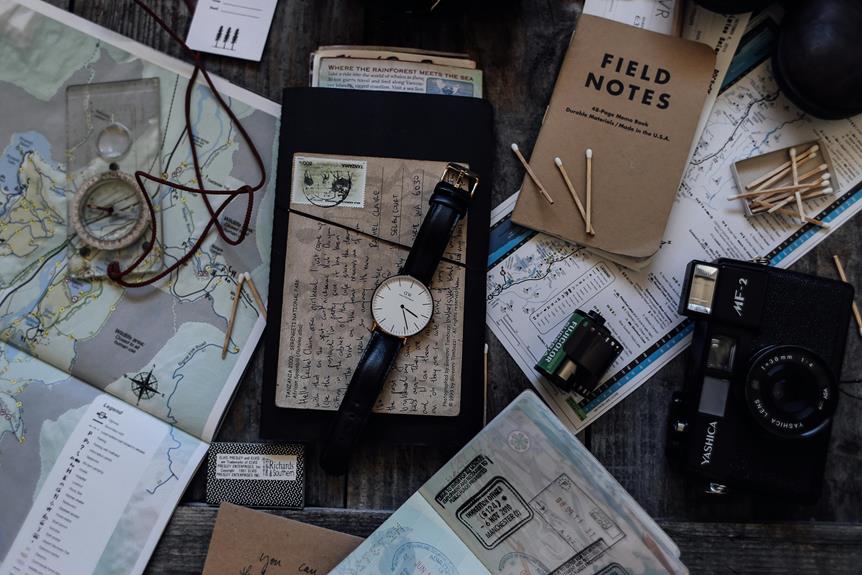Unlock the potential of acetates as your creative canvas and watch your artistic visions take flight. By following a few expert techniques, you can transform these transparent sheets into mesmerizing works of art that captivate viewers.
From layering colors to creating stunning visual effects, the possibilities are endless. Prepare to elevate your artistry and discover the secrets to creating captivating artwork that will leave an impression long after it's finished.
Acetates: Essential Materials and Tools
To create artwork with acetates, you'll need a few essential materials and tools. Firstly, gather your acetate sheets, which are transparent and come in various sizes. These will be the base for your artwork. Next, have your preferred paints or markers ready. Acrylic paints work well on acetates, giving vibrant and long-lasting colors. Additionally, make sure to have brushes or fine-tip markers for detailed work.
A lightbox or a well-lit table is crucial for tracing or sketching your designs onto the acetate. This will help you transfer your ideas accurately. To secure your acetate while working, use masking tape to keep it in place on the surface.
Lastly, have a clean cloth or gloves on hand to prevent smudges on the acetate. Remember to work in a well-ventilated area to avoid inhaling fumes from the paints. With these materials and tools, you're ready to start creating beautiful artwork on acetates.
Preparing Your Artwork Surface
If you're ready to move forward with your artwork, the first step is to prepare the surface for your creative process. Start by ensuring your acetate sheet is clean and free of any dust or debris. Wipe it down gently with a soft, lint-free cloth to create a smooth working surface.
Next, consider the size of your artwork and trim the acetate sheet accordingly. Use a sharp pair of scissors or a craft knife to achieve clean, precise edges. Remember to handle the acetate carefully to avoid any scratches or marks that could show up in your final piece.
Once your acetate sheet is clean and trimmed to the desired size, you can begin to sketch or outline your design directly onto the surface. Acetate is transparent, so you can use this as a guide for your painting or drawing.
Mastering Acetate Painting Techniques
Explore various painting techniques to elevate your artwork on acetate and achieve stunning visual effects. When working with acetate, consider using acrylic paints for their quick-drying properties and vibrant colors. Experiment with blending colors directly on the acetate to create smooth transitions and gradients. Try using different brushes to achieve various textures and effects; for example, use a fine brush for intricate details and a flat brush for broad strokes.
To add depth to your artwork, try layering different colors and allowing each layer to dry before adding the next. This technique can create a sense of dimension and complexity in your design. Additionally, consider incorporating mixed media elements such as markers or colored pencils to enhance certain areas of your acetate painting.
Don't be afraid to play with light and transparency. Utilize the clear nature of acetate to your advantage by incorporating negative space into your design, allowing light to pass through certain areas and create interesting shadows. Experiment with different lighting sources to see how they interact with your acetate artwork, adding another layer of visual interest. By mastering these techniques, you can take your acetate painting to the next level and create truly captivating pieces.
Adding Depth and Dimension
Enhance your acetate artwork by incorporating strategic layering techniques to add depth and dimension. By carefully layering different elements of your design on separate sheets of acetate, you can create a sense of depth that draws the viewer into your artwork.
Start by identifying the foreground elements that you want to stand out the most. These could be the focal point of your piece or objects that are closest to the viewer. Place these elements on the top layer of acetate to make them pop.
Next, consider the middle ground of your artwork. These elements should be placed on a separate sheet of acetate behind the foreground layer. This will create a sense of distance between the foreground and middle ground, adding depth to your composition.
Finishing Touches and Display Options
To add the final touches to your acetate artwork and explore various display options, consider incorporating unique framing techniques that complement the transparency of acetate.
One way to enhance the presentation of your acetate piece is by using a floating frame. This type of frame allows the artwork to appear as if it's suspended within the frame, creating a modern and sleek look that highlights the transparency of the acetate.
Additionally, you can experiment with backlit display options to illuminate your artwork from behind, emphasizing the vivid colors and intricate details of your creation.
Another way to elevate your acetate artwork is by mounting it onto a clear acrylic panel. This method not only protects the artwork but also gives it a contemporary and polished finish.
The clear acrylic panel adds a layer of depth to your artwork while maintaining the transparency that makes acetate pieces unique. By carefully considering the framing and display options for your acetate artwork, you can create a stunning presentation that showcases the beauty and intricacy of your creation.
Frequently Asked Questions
Are There Any Specific Safety Precautions to Keep in Mind When Working With Acetates?
When working with acetates, always wear protective gloves and goggles to shield your skin and eyes from potential irritation. Ensure good ventilation in your workspace to avoid inhaling fumes. Safety first!
How Do You Store Acetate Artwork to Prevent Damage or Warping?
To store acetate artwork and prevent damage or warping, place them flat in a cool, dry area away from direct sunlight or heat sources. Avoid bending or stacking them with heavy objects on top. Proper storage helps maintain their quality.
Can Acetate Paintings Be Framed Like Traditional Artwork, or Are There Specific Considerations to Keep in Mind?
When framing acetate paintings, ensure the frame material won't react with the acetate. Avoid direct contact between the acetate and the frame by using spacers. UV-protective glass will shield the artwork from fading.
Are There Any Special Techniques for Cleaning and Maintaining Acetate Artwork?
To clean and maintain acetate artwork, gently dust with a soft, dry cloth or use a mild soap solution if needed. Avoid harsh chemicals or vigorous scrubbing to preserve the delicate surface. Regular care will keep your artwork looking vibrant.
Can Acetate Paintings Be Displayed Outdoors or in Direct Sunlight Without Being Damaged?
Yes, you can display acetate paintings outdoors or in direct sunlight, but prolonged exposure may cause fading or damage. To preserve your artwork, consider using UV-protective framing or limiting direct sunlight exposure.
Conclusion
Now that you've learned the basics of creating stunning artwork with acetates, the possibilities are endless.
With the right materials and techniques, you can bring your vision to life with depth and dimension.
Don't forget to add those finishing touches and consider different display options to truly showcase your masterpiece.
Let your creativity flow and see where acetates can take you in your artistic journey. Happy creating!








